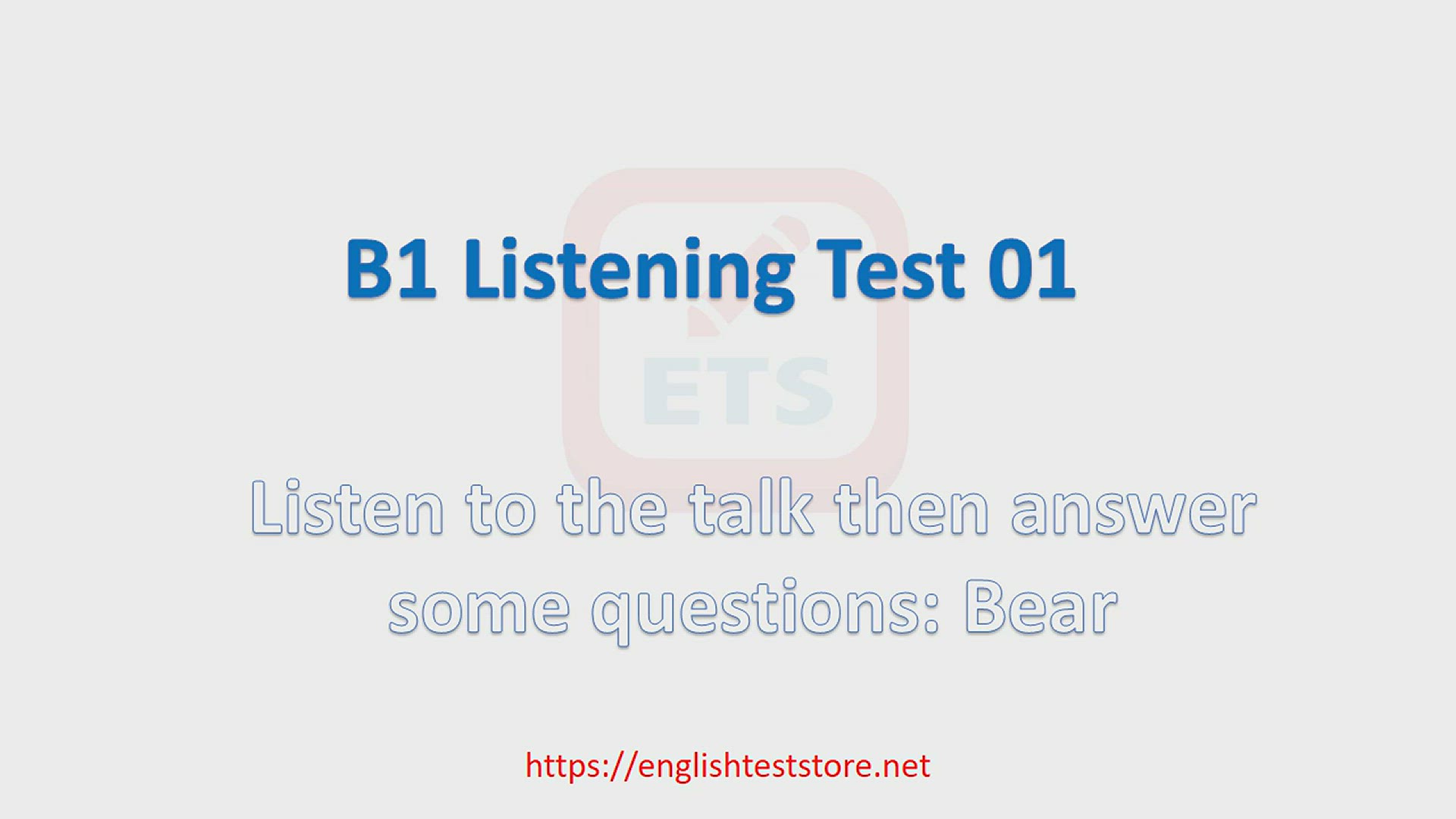
English B1 Listening Practice Test 01
9K views · Feb 15, 2023 englishteststore.net
This video helps you practice the B1 Listening skills. Listen to a talk then answer some questions about bears.
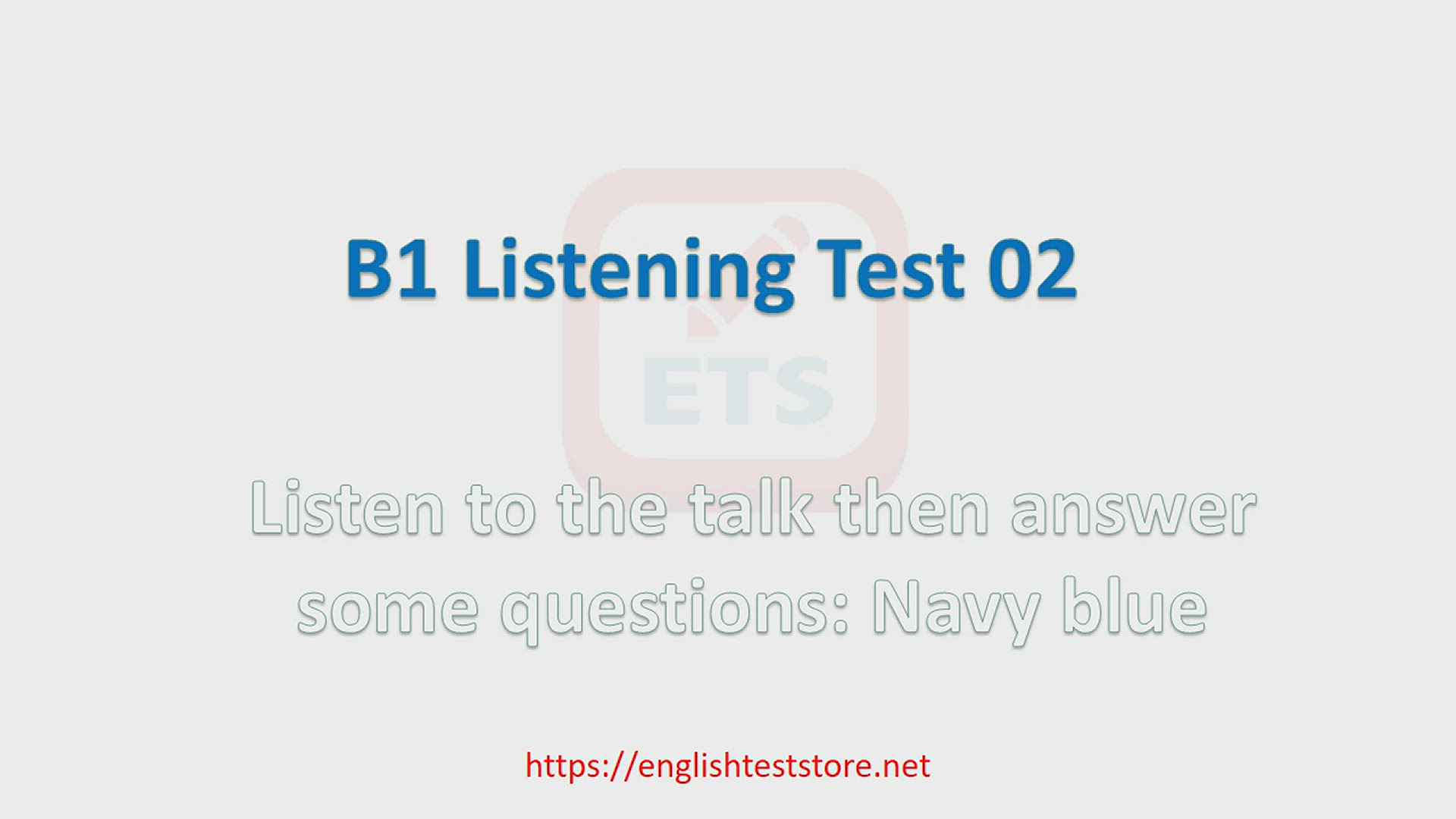
English B1 Listening Practice Test 02
11K views · Feb 15, 2023 englishteststore.net
This video helps you practice the B1 Listening skills. Listen to a talk then answer some questions about Navy blue color.

English B1 Listening Practice Test 03
56K views · Feb 15, 2023 englishteststore.net
This video helps you practice the B1 Listening skills. Listen to a talk then answer some questions about Coffee.

English B1 Listening Practice Test 03
56K views · Feb 15, 2023 englishteststore.net
This video helps you practice the B1 Listening skills. Listen to a talk then answer some questions about Coffee.
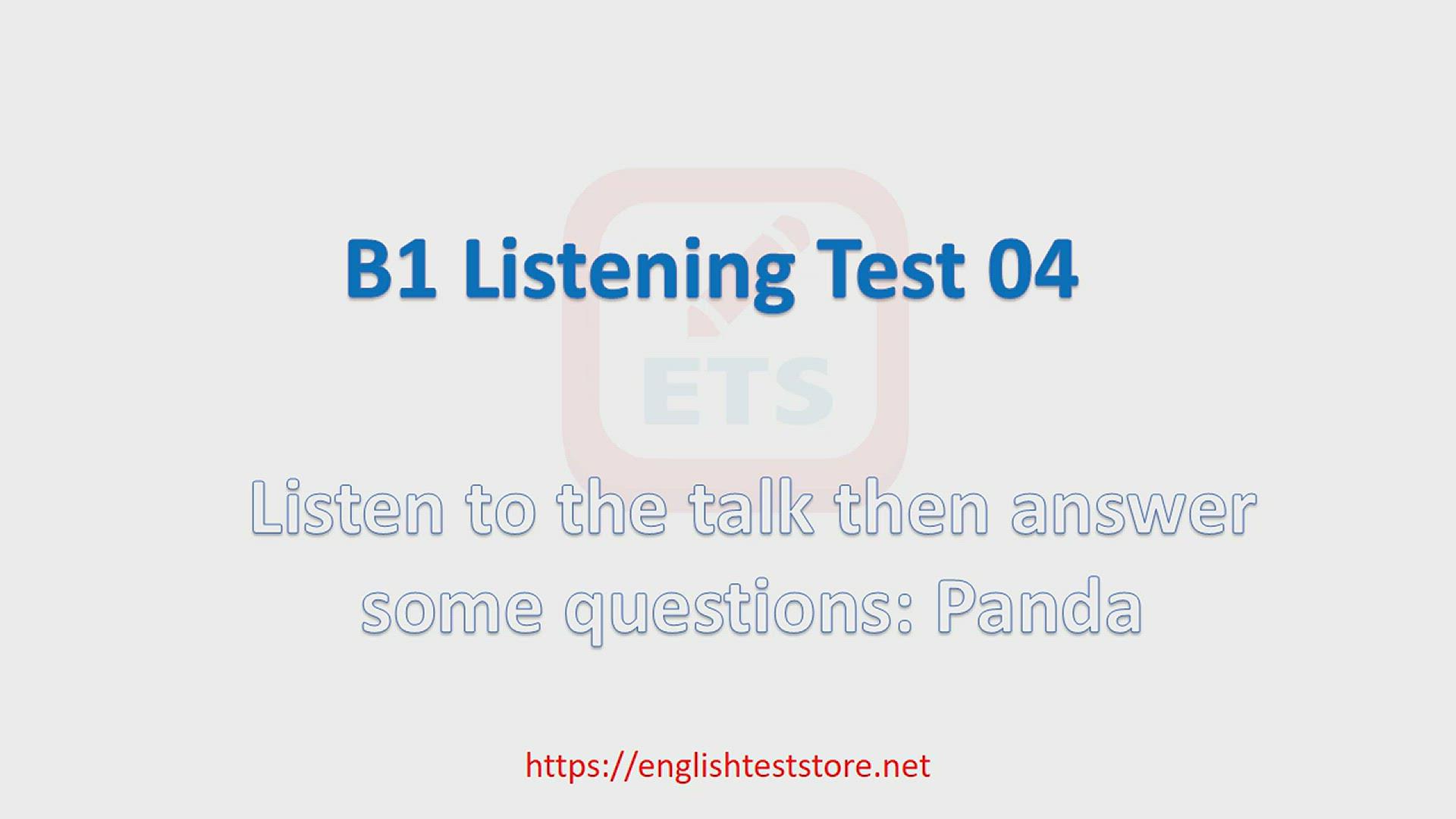
English B1 Listening Practice Test 04
8K views · Feb 15, 2023 englishteststore.net
This video helps you practice the B1 Listening skills. Listen to a talk then answer some questions about panda.
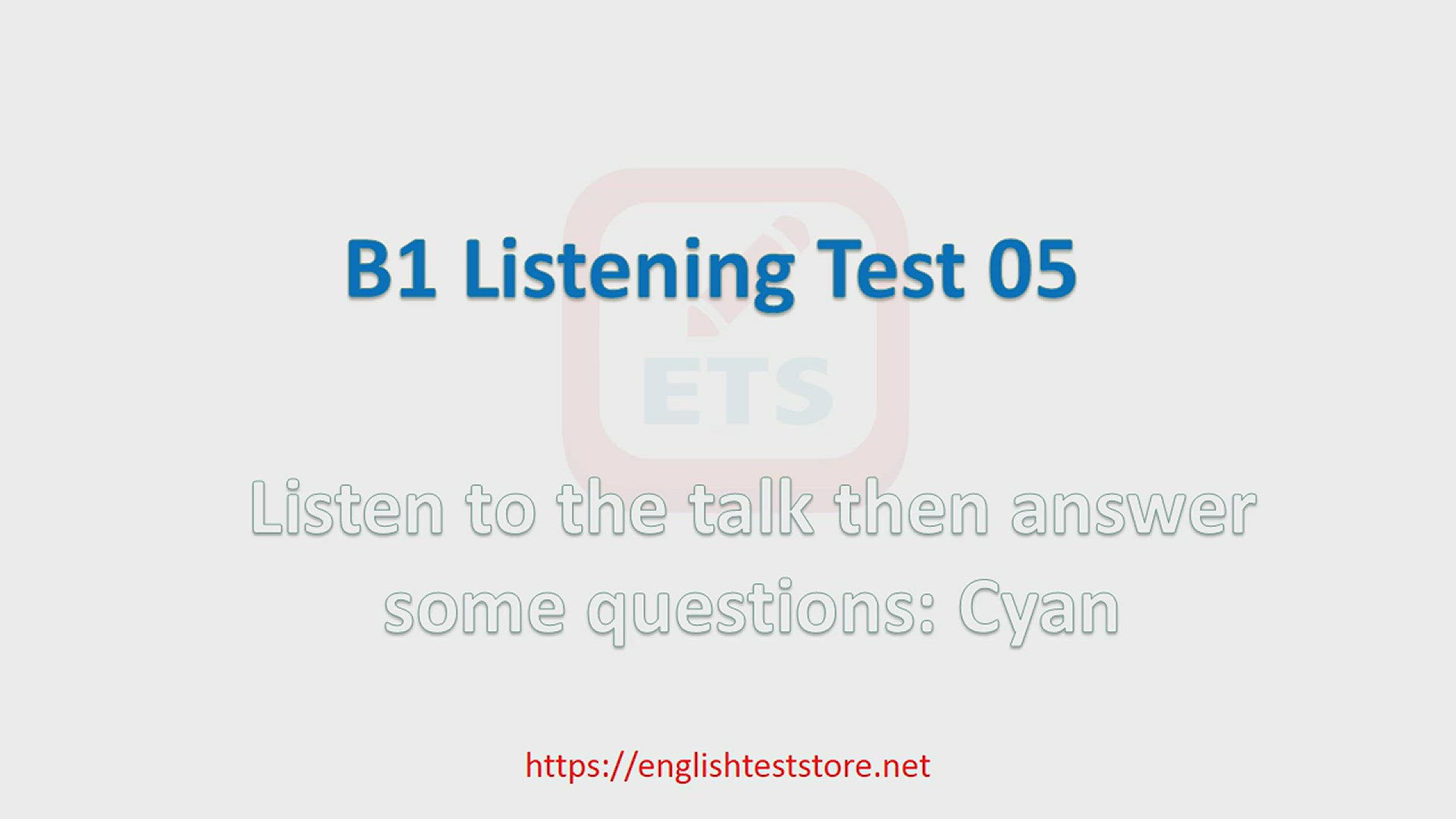
English B1 Listening Practice Test 05
6K views · Feb 15, 2023 englishteststore.net
This video helps you practice the B1 Listening skills. Listen to a talk then answer some questions about Cyan.
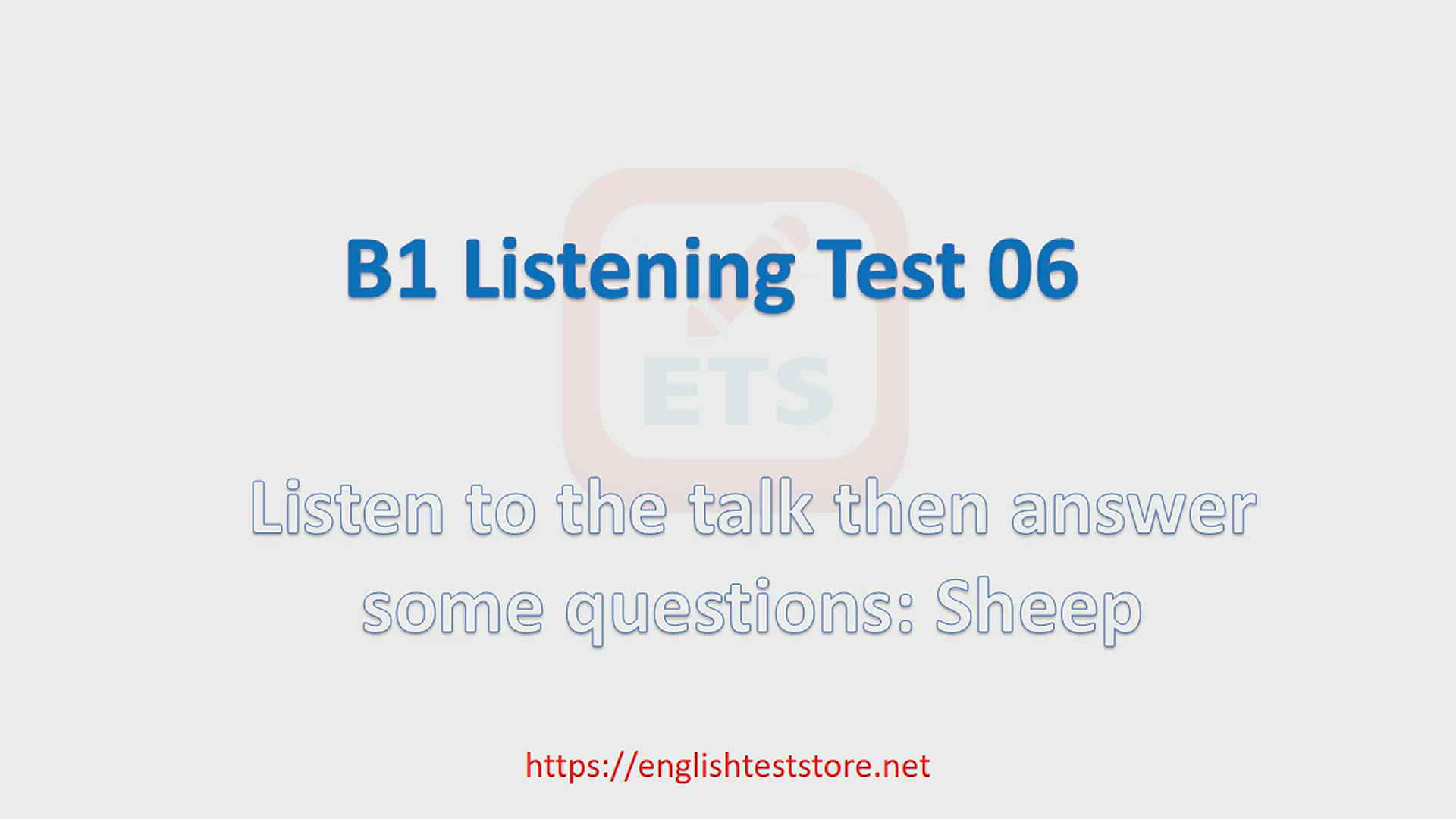
English B1 Listening Practice Test 06
7K views · Feb 15, 2023 englishteststore.net
This video helps you practice the B1 Listening skills. Listen to a talk then answer some questions about sheep.
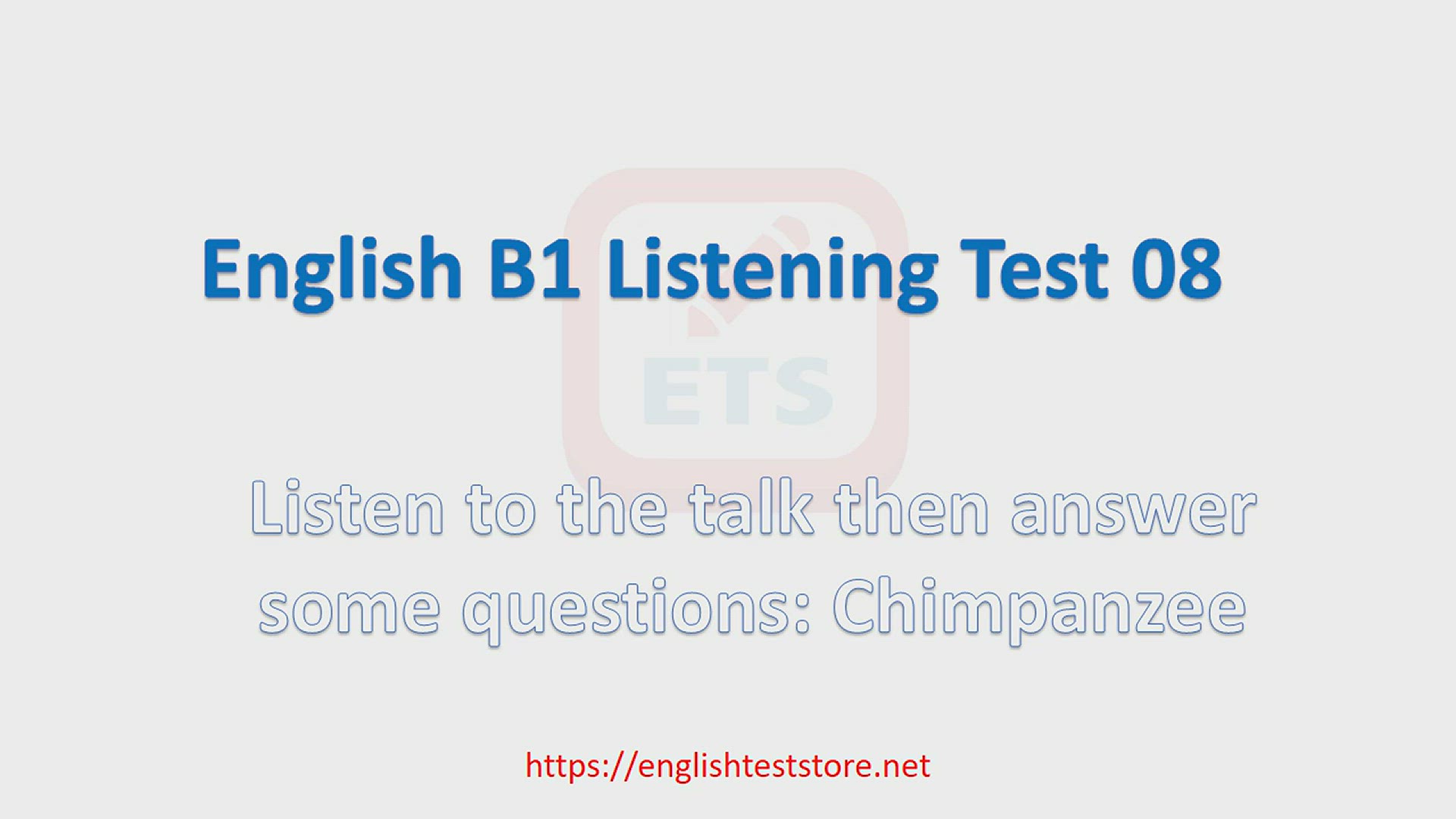
English B1 Listening Practice Test 08
690 views · Feb 15, 2023 englishteststore.net
This video helps you practice the B1 Listening skills. Listen to a talk then answer some questions about Chimpanzee.
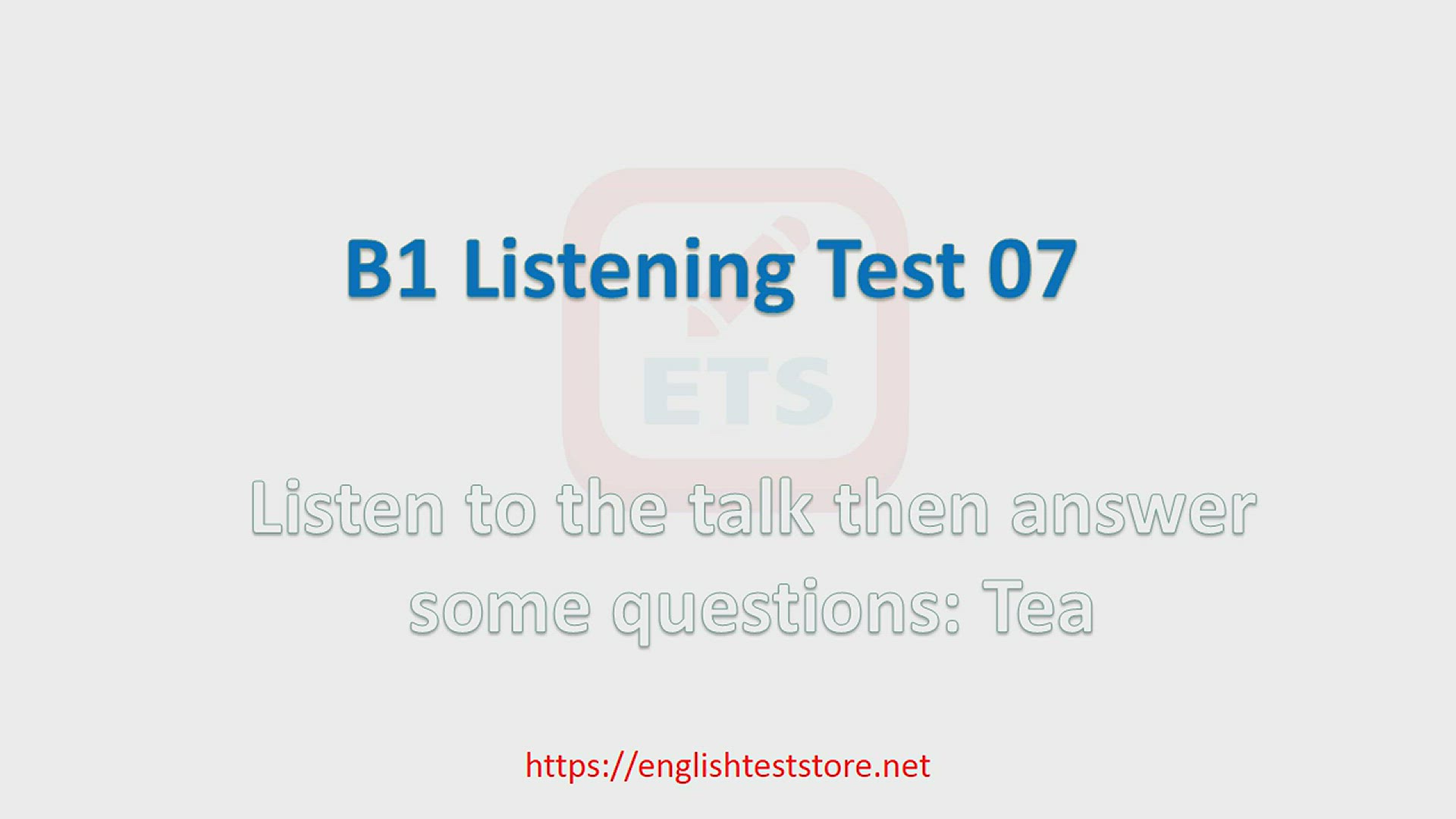
English B1 Listening Practice Test 07
63K views · Feb 15, 2023 englishteststore.net
This video helps you practice the B1 Listening skills. Listen to a talk then answer some questions about Tea.
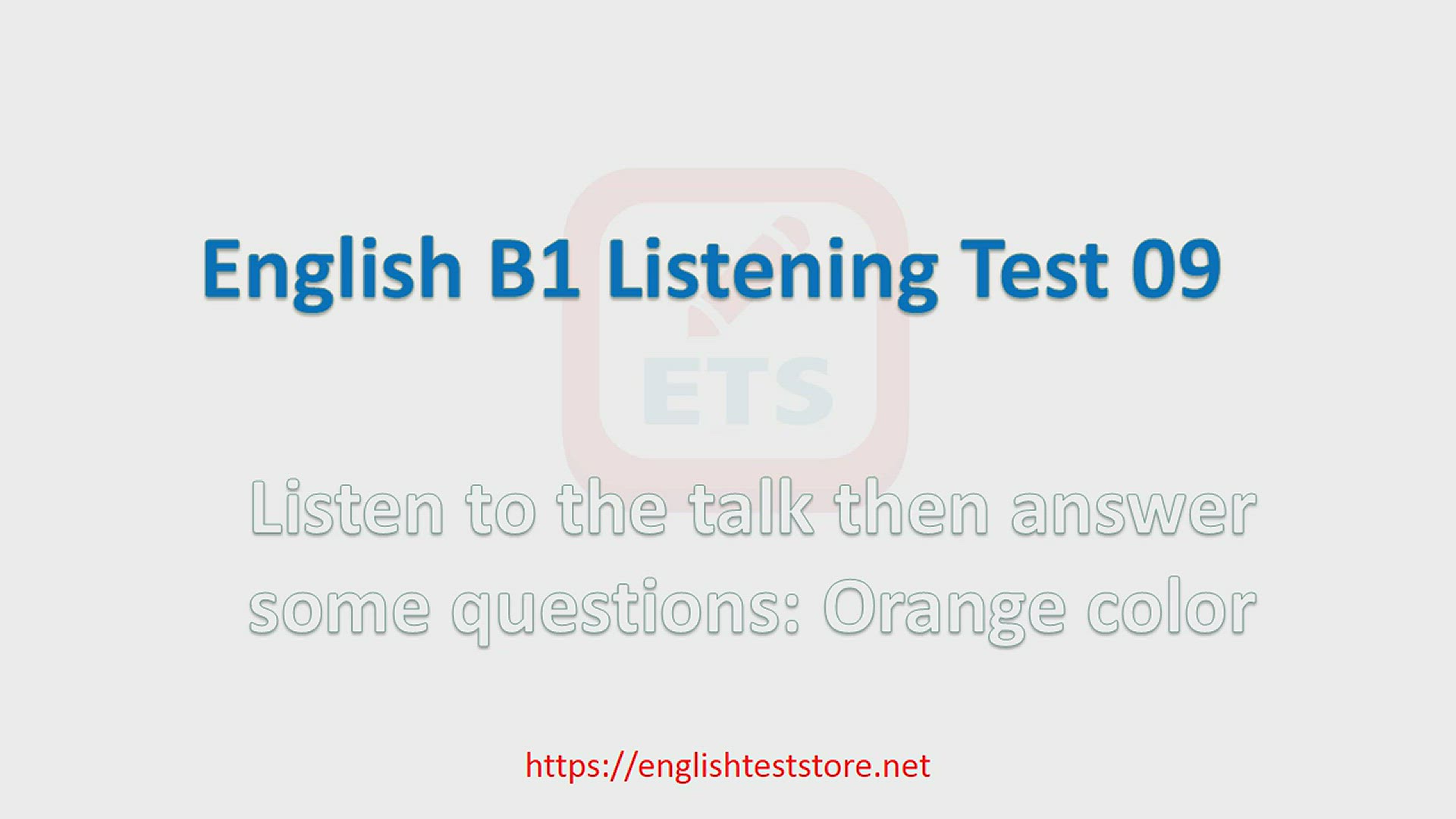
English B1 Listening Practice Test 09
4K views · Feb 15, 2023 englishteststore.net
This video helps you practice the B1 Listening skills. Listen to a talk then answer some questions about Orange color.
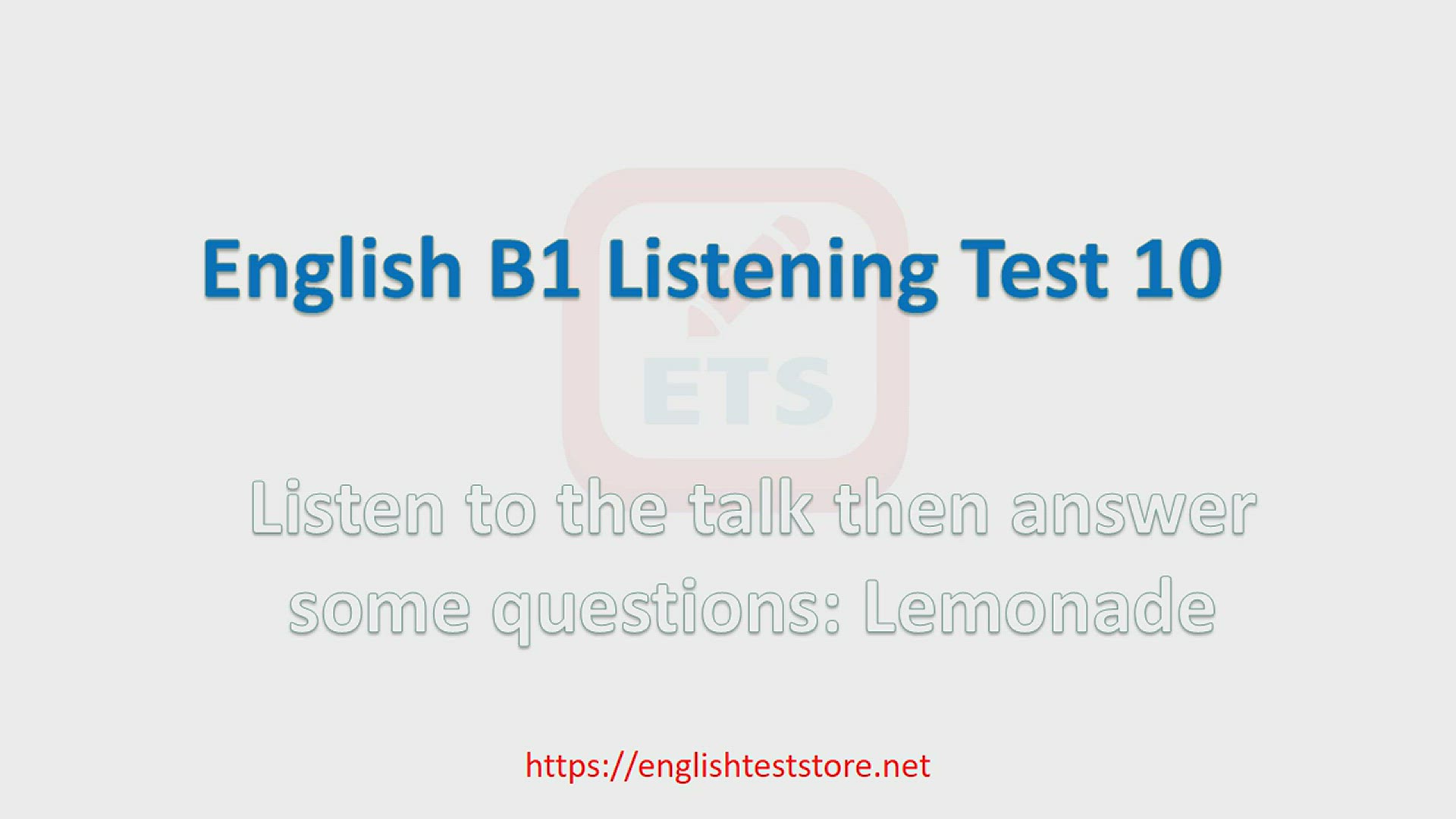
English B1 Listening Practice Test 10
6K views · Feb 15, 2023 englishteststore.net
This video helps you practice the B1 Listening skills. Listen to a talk then answer some questions about Lemonade.

Top 10 English Grammar Myths in Popular Culture
2K views · Nov 15, 2023 englishteststore.net
Top 10 English Grammar Myths in Popular Culture Introduction: Grammar Myths in Popular Culture Hello everyone! Welcome to our channel. Today, we're going to dive into the world of English grammar and debunk some of the most common myths that have been popularized by movies, TV shows, and even songs. Let's get started! Myth 1: Starting a Sentence with 'And' or 'But' is Incorrect Contrary to what you might have heard, starting a sentence with 'and' or 'but' is not grammatically incorrect. In fact, it can add emphasis or create a more conversational tone. However, it's important to use this technique sparingly and not overdo it. Myth 2: Double Negatives are Always Wrong While it's true that double negatives can create confusion, they are not always incorrect. In some dialects and informal speech, double negatives are used for emphasis or to convey a different meaning. However, in formal writing, it's best to avoid them. Myth 3: 'Ain't' is Not a Real Word Many people believe that 'ain't' is not a proper word. However, it has been used in English for centuries, and even though it's considered informal, it has its place in certain contexts. Just be mindful of when and where you use it. Myth 4: 'I Before E Except After C' is a Foolproof Rule We've all been taught the 'I before E except after C' rule. While it's a helpful guideline, there are many exceptions to it. Words like 'weird' and 'science' break this rule. So, it's always a good idea to consult a dictionary if you're unsure. Myth 5: 'Irregardless' is Not a Word You might have been told that 'irregardless' is not a real word and that you should use 'regardless' instead. However, 'irregardless' is widely used, although it's considered nonstandard. If you're writing formally, it's best to stick with 'regardless.' Myth 6: 'They' Can Only Refer to Plural Nouns In traditional grammar, 'they' is used to refer to plural nouns, while 'he' or 'she' is used for singular nouns. However, in modern usage, 'they' is also used as a gender-neutral pronoun. This inclusive language is becoming more prevalent. Myth 7: 'Literally' Should Only be Used for Literal Meanings The word 'literally' is often misused, especially in informal speech. While it should ideally be used for literal meanings, it has also taken on a figurative sense. For example, 'I literally died laughing.' In such cases, it's used for emphasis. Myth 8: 'Me' Should Always Come After 'I' You might have been scolded for saying 'Me and my friend went to the movies.' While 'My friend and I' is grammatically correct, 'Me and my friend' is also widely used in informal speech. Language is constantly evolving, and usage plays a big role. Myth 9: 'Fewer' and 'Less' are Interchangeable There's a common misconception that 'fewer' and 'less' can be used interchangeably. However, they have distinct uses. 'Fewer' is used for countable nouns, while 'less' is used for uncountable nouns. For example, 'fewer apples' and 'less water.' Myth 10: 'Split Infinitives' are Always Incorrect A split infinitive is when an adverb is placed between 'to' and the verb, like in 'to boldly go.' While some traditionalists consider this incorrect, it's widely accepted in modern usage. The key is to ensure clarity and not create ambiguity. Conclusion: The Importance of Grammar Accuracy While it's true that language is constantly evolving, having a good grasp of grammar is still important. It allows us to communicate effectively and ensures clarity in our writing. So, while it's okay to break some rules, it's crucial to know them first. That's all for today's video. If you found it informative, don't forget to give it a thumbs up and subscribe to our channel. Until next time, happy learning!

Top 10 English Grammar Rules for Writing in Psychology
759 views · Nov 19, 2023 englishteststore.net
Top 10 English Grammar Rules for Writing in Psychology 1. Subject-Verb Agreement Ensuring that the subject and verb in a sentence agree in number is crucial. For example, 'The participants were' rather than 'The participants was.' 2. Proper Use of Tenses Consistency in using past, present, and future tenses is essential. Avoid unnecessary shifts that can confuse the reader. 3. Active Voice Using the active voice instead of the passive voice adds clarity and directness to your writing. It also makes it more engaging to read. 4. Parallel Structure When listing items or ideas, ensure they are in the same grammatical form. This creates a balanced and organized structure. 5. Proper Use of Articles Understanding when to use 'a,' 'an,' or 'the' can significantly impact the meaning of a sentence. Be mindful of their usage. 6. Consistent Pronoun Usage When referring to a noun, use the appropriate pronoun consistently. Avoid switching between 'he,' 'she,' and 'they' without clarity. 7. Sentence Fragments Ensure that every sentence has a subject and a verb. Fragments can make your writing disjointed and confusing. 8. Comma Usage Using commas correctly can help clarify meaning and improve the flow of your writing. Be aware of their various uses. 9. Avoiding Run-On Sentences Long, run-on sentences can be overwhelming for the reader. Break them down into shorter, more manageable sentences. 10. Consistent Capitalization Follow the appropriate rules for capitalizing headings, titles, and proper nouns. Inconsistencies can be distracting.

Top 10 Commonly Confused Words in Inflammation Biology
797 views · Dec 5, 2023 englishteststore.net
Top 10 Commonly Confused Words in Inflammation Biology 1. Inflammation vs. Infection One of the most fundamental distinctions to make is between inflammation and infection. Inflammation is the body's natural response to tissue damage, while infection refers to the invasion of harmful microorganisms. Although they can occur together, it's crucial to understand that inflammation can happen without an infection and vice versa. 2. Acute vs. Chronic Another pair of terms that often perplex students are acute and chronic. Acute inflammation is a rapid and short-lived response, usually occurring after an injury or infection. On the other hand, chronic inflammation is a prolonged and persistent state, often linked to conditions like arthritis or autoimmune diseases. 3. Cytokines vs. Chemokines Cytokines and chemokines are signaling molecules involved in inflammation. Cytokines are broad-acting, regulating various immune responses, while chemokines specifically attract immune cells to the site of inflammation. Think of cytokines as the coordinators and chemokines as the recruiters. 4. Neutrophils vs. Macrophages Neutrophils and macrophages are types of white blood cells crucial in inflammation. Neutrophils are the first responders, arriving early at the site and engulfing pathogens. Macrophages, on the other hand, are like the cleanup crew, removing debris and dead cells. Both play vital roles in the inflammatory process. 5. Vasodilation vs. Vasoconstriction Vasodilation and vasoconstriction refer to the widening and narrowing of blood vessels, respectively. In inflammation, vasodilation occurs, leading to increased blood flow, redness, and warmth. Vasoconstriction, on the other hand, can happen later, helping to control the inflammatory response. 6. Exudate vs. Transudate Exudate and transudate are types of fluids that can accumulate during inflammation. Exudate is rich in proteins, cells, and debris, indicating a more severe response. Transudate, on the other hand, is a relatively clear fluid with fewer components. The type of fluid can provide insights into the nature of the inflammation. 7. Edema vs. Effusion Edema and effusion both refer to the accumulation of fluid. Edema occurs in the tissue spaces, leading to swelling, while effusion is the collection of fluid in body cavities, such as the pleural or pericardial cavity. The location of fluid accumulation helps differentiate between the two. 8. Fibrosis vs. Granulation Fibrosis and granulation are two processes involved in tissue repair after inflammation. Fibrosis is the formation of scar tissue, which is composed mainly of collagen. Granulation, on the other hand, is the initial stage of tissue repair, characterized by the formation of new blood vessels and connective tissue. 9. Resolution vs. Abscess Resolution and abscess are two possible outcomes of inflammation. Resolution refers to the complete restoration of tissue structure and function. However, in some cases, if the inflammatory process is not adequately controlled, an abscess can form - a localized collection of pus. 10. Anti-inflammatory vs. Pro-inflammatory Lastly, the terms anti-inflammatory and pro-inflammatory describe substances or processes that either suppress or promote inflammation, respectively. Balancing these factors is crucial for maintaining a healthy inflammatory response. Conclusion And that concludes our discussion on the top 10 commonly confused words in inflammation biology. By understanding these terms, you'll be better equipped to navigate the complexities of this field. Remember, continuous learning and clarification are key to mastering any subject. Thank you for watching, and until next time, happy learning!

Top 10 Commonly Confused Words in Neuroendocrinology
194 views · Dec 5, 2023 englishteststore.net
Top 10 Commonly Confused Words in Neuroendocrinology 1. Hormone vs. Neurotransmitter Hormones and neurotransmitters both play crucial roles in our body's communication systems. However, the key distinction lies in their reach. While hormones travel through the bloodstream, neurotransmitters act locally, transmitting signals between neurons. So, think of hormones as long-distance messengers and neurotransmitters as local couriers. 2. Hypothalamus vs. Pituitary Gland Often referred to as the 'master gland,' the pituitary gland is responsible for regulating several hormones. However, it doesn't act alone. It takes cues from the hypothalamus, which acts as the 'command center.' So, if the pituitary gland is the conductor, the hypothalamus is the orchestra leader. 3. Endocrine vs. Exocrine Glands Glands are essential for hormone production. Endocrine glands, like the thyroid, release hormones directly into the bloodstream. On the other hand, exocrine glands, such as sweat glands, secrete substances through ducts. So, while endocrine glands are like 'internal secretaries,' exocrine glands are 'external messengers.' 4. Steroid vs. Peptide Hormones Steroid and peptide hormones are two major types. Steroid hormones, like cortisol, are derived from cholesterol and can easily pass through cell membranes. Peptide hormones, such as insulin, are made up of amino acids and require receptors on the cell surface. So, think of steroid hormones as 'VIPs' with direct access and peptide hormones as 'guests' who need an invitation. 5. Negative vs. Positive Feedback Feedback mechanisms are crucial for maintaining homeostasis. Negative feedback, like a thermostat, works to bring a system back to its set point. Positive feedback, on the other hand, amplifies a response, like in childbirth. So, negative feedback is like a 'stabilizer,' while positive feedback is an 'accelerator.' 6. Neurotransmission vs. Neuromodulation Neurotransmission and neuromodulation are both involved in neuronal communication. Neurotransmission refers to the rapid, point-to-point signaling, like a phone call. Neuromodulation, on the other hand, involves more widespread, slower effects, like a radio broadcast. So, neurotransmission is like a 'whisper,' while neuromodulation is a 'broadcast.' 7. Agonist vs. Antagonist In pharmacology, agonists and antagonists have opposing actions. An agonist activates a receptor, mimicking the natural ligand. An antagonist, on the other hand, blocks the receptor, preventing activation. So, think of an agonist as a 'key' that unlocks a door, while an antagonist is a 'stopper' that blocks it. 8. Neurogenesis vs. Neuroplasticity The brain is incredibly dynamic. Neurogenesis refers to the birth of new neurons, crucial for learning and memory. Neuroplasticity, on the other hand, is the brain's ability to reorganize and form new connections. So, neurogenesis is like 'new recruits,' while neuroplasticity is 'team restructuring.' 9. Vasopressin vs. Oxytocin Vasopressin and oxytocin are often referred to as 'sibling hormones.' While they share some similarities, they have distinct functions. Vasopressin regulates water balance and blood pressure, earning it the nickname 'antidiuretic hormone.' Oxytocin, on the other hand, is involved in social bonding and childbirth. So, vasopressin is like a 'plumber,' while oxytocin is a 'social glue.' 10. Circadian Rhythm vs. Ultradian Rhythm Our body's internal clock is fascinating. The circadian rhythm follows a 24-hour cycle, regulating sleep-wake patterns. Ultradian rhythms, on the other hand, are shorter, repetitive cycles, like the stages of sleep. So, think of the circadian rhythm as the 'daily conductor,' while ultradian rhythms are like 'musical notes' within the day. Conclusion And there you have it! The top 10 commonly confused words in neuroendocrinology. By understanding these distinctions, you'll have a solid foundation for your studies in this captivating field. Remember, clarity in terminology leads to clarity in knowledge. Happy learning, and see you in the next video!

Top 10 Commonly Confused Words in Paleoanthropology
694 views · Dec 5, 2023 englishteststore.net
Top 10 Commonly Confused Words in Paleoanthropology 1. Hominid vs. Hominin The terms 'hominid' and 'hominin' are often used interchangeably, but they have distinct meanings. Hominid refers to all modern and extinct great apes, including humans. On the other hand, hominin specifically refers to the human lineage after it split from the chimpanzee lineage. So, while all hominins are hominids, not all hominids are hominins. 2. Australopithecus vs. Homo Australopithecus and Homo are two genera of early hominins. Australopithecus species, like the famous 'Lucy,' lived between 4 and 2 million years ago. Homo species, including Homo habilis and Homo erectus, appeared later. The key difference is that Homo species, including modern humans, had larger brains and more advanced tool-making abilities. 3. Paleolithic vs. Neolithic The Paleolithic and Neolithic are two distinct periods in human prehistory. The Paleolithic, also known as the Old Stone Age, lasted from around 2.6 million years ago to about 10,000 BCE. It was characterized by hunting and gathering. The Neolithic, or New Stone Age, followed, and it marked the transition to agriculture and the domestication of animals. 4. Fossil vs. Artifact Fossils and artifacts are both important in paleoanthropology, but they differ in origin. Fossils are the preserved remains of ancient organisms, like bones or teeth. Artifacts, on the other hand, are objects made or modified by humans, such as tools or pottery. While fossils provide insights into ancient life, artifacts offer clues about human culture and behavior. 5. Bipedalism vs. Quadrupedalism Bipedalism and quadrupedalism refer to different modes of locomotion. Bipedalism is walking on two legs, a defining characteristic of humans. Quadrupedalism, on the other hand, is walking on all fours, like most primates. The transition from quadrupedalism to bipedalism was a significant milestone in human evolution. 6. Prehensile vs. Non-Prehensile Prehensile and non-prehensile are terms used to describe the grasping capabilities of hands or tails. Prehensile means capable of grasping, like the hands of primates. Non-prehensile refers to the inability to grasp, as seen in most other animals. The prehensile hands of primates were crucial for tasks like tool use and gathering food. 7. Megafauna vs. Microfauna Megafauna and microfauna are terms used to describe the size of animal species. Megafauna refers to large animals, often weighing over 100 kilograms. Examples include mammoths and giant sloths. Microfauna, on the other hand, are tiny organisms, like insects or small rodents. The extinction of many megafauna species had significant ecological impacts. 8. Hominization vs. Hominidization Hominization and hominidization are terms used to describe the process of human evolution. Hominization refers to the biological changes that led to the emergence of the human species. Hominidization, on the other hand, encompasses not just the biological changes but also the cultural and behavioral aspects of human evolution. 9. Taphonomy vs. Stratigraphy Taphonomy and stratigraphy are two important branches of paleoanthropology. Taphonomy is the study of how organisms decay and become fossilized. It provides insights into the formation and preservation of fossils. Stratigraphy, on the other hand, is the study of rock layers or strata. It helps in determining the relative ages of fossils and artifacts. 10. Paleodemography vs. Paleopathology Paleodemography and paleopathology are two areas of study in paleoanthropology. Paleodemography focuses on reconstructing ancient populations, including their size and structure. Paleopathology, on the other hand, examines ancient diseases and injuries. Both fields contribute to our understanding of past human societies. Conclusion And that wraps up our discussion on the top 10 commonly confused words in paleoanthropology. By understanding these terms, you'll have a solid foundation in this captivating field. Keep exploring, and who knows, you might make your own groundbreaking discoveries one day. Thank you for watching, and see you in the next lesson!

Top 10 Commonly Confused Words in Space Engineering
3K views · Dec 6, 2023 englishteststore.net
Top 10 Commonly Confused Words in Space Engineering 1. Orbit vs. Trajectory The terms 'orbit' and 'trajectory' are often used interchangeably, but they have distinct meanings. An orbit refers to the path an object takes around a celestial body, such as a satellite around the Earth. On the other hand, a trajectory refers to the path an object takes through space, including its initial and final positions. While an orbit is a specific type of trajectory, not all trajectories are orbits. 2. Thrust vs. Torque When it comes to propulsion systems, 'thrust' and 'torque' are crucial concepts. Thrust is the force that propels a spacecraft forward, generated by engines. Torque, on the other hand, is the rotational force that causes an object to rotate. While both are forces, they act in different ways and have distinct applications in space engineering. 3. Satellite vs. Spacecraft While 'satellite' and 'spacecraft' are often used interchangeably, there's a subtle difference. A satellite is an object that orbits a celestial body, such as a planet or a moon. It can be natural, like the Moon, or artificial, like a communication satellite. On the other hand, a spacecraft is a vehicle designed for travel or operation in space. All satellites are spacecraft, but not all spacecraft are satellites. 4. Solar System vs. Galaxy The terms 'solar system' and 'galaxy' refer to different scales of celestial structures. A solar system consists of a star, like our Sun, and all the objects that orbit it, including planets, moons, asteroids, and comets. In contrast, a galaxy is a vast collection of stars, gas, and dust, held together by gravity. Our solar system is just a tiny part of the Milky Way galaxy. 5. Cosmonaut vs. Astronaut The terms 'cosmonaut' and 'astronaut' are used to describe individuals who travel to space. However, the usage depends on the country. Cosmonaut is commonly used in Russia, while astronaut is used by NASA and other international space agencies. Despite the difference in terminology, both cosmonauts and astronauts undergo rigorous training and play crucial roles in space missions. 6. Rocket vs. Space Shuttle When it comes to space transportation, 'rocket' and 'space shuttle' are two common terms. A rocket is a vehicle that propels itself by ejecting exhaust gases at high speeds. It's often used for satellite launches. On the other hand, a space shuttle is a reusable spacecraft designed for human spaceflight. While all space shuttles are rockets, not all rockets are space shuttles. 7. Lander vs. Rover In planetary exploration, 'lander' and 'rover' are two types of spacecraft. A lander is a vehicle designed to touch down on the surface of a celestial body, like a planet or a moon. It remains stationary or performs limited movements. In contrast, a rover is a mobile robot that explores the surface, often equipped with instruments for scientific research. A rover is usually deployed from a lander. 8. Geostationary vs. Geosynchronous The terms 'geostationary' and 'geosynchronous' are often used in the context of satellite orbits. A geostationary orbit is one in which a satellite appears to be stationary relative to a point on Earth's surface. This is achieved by placing the satellite at an altitude of around 36,000 kilometers. A geosynchronous orbit, on the other hand, is an orbit with the same period as Earth's rotation, but it may have some inclination or eccentricity. 9. Escape Velocity vs. Orbital Velocity When it comes to leaving a celestial body, such as Earth, two velocities are crucial. The escape velocity is the minimum speed an object needs to overcome the planet's gravitational pull and move into space. The orbital velocity, on the other hand, is the speed required to maintain a stable orbit around the planet. The escape velocity is higher than the orbital velocity, as it involves completely leaving the planet's gravitational influence. 10. Celestial Equator vs. Ecliptic In celestial coordinate systems, the celestial equator and the ecliptic are important reference planes. The celestial equator is a projection of Earth's equator onto the celestial sphere. It divides the sky into the northern and southern hemispheres. The ecliptic, on the other hand, is the apparent path of the Sun in the sky throughout the year. It's also the plane in which Earth orbits the Sun. Conclusion Understanding the precise meanings of technical terms is crucial in space engineering. By clarifying the commonly confused words we discussed today, we hope to enhance your knowledge and prevent any misunderstandings.
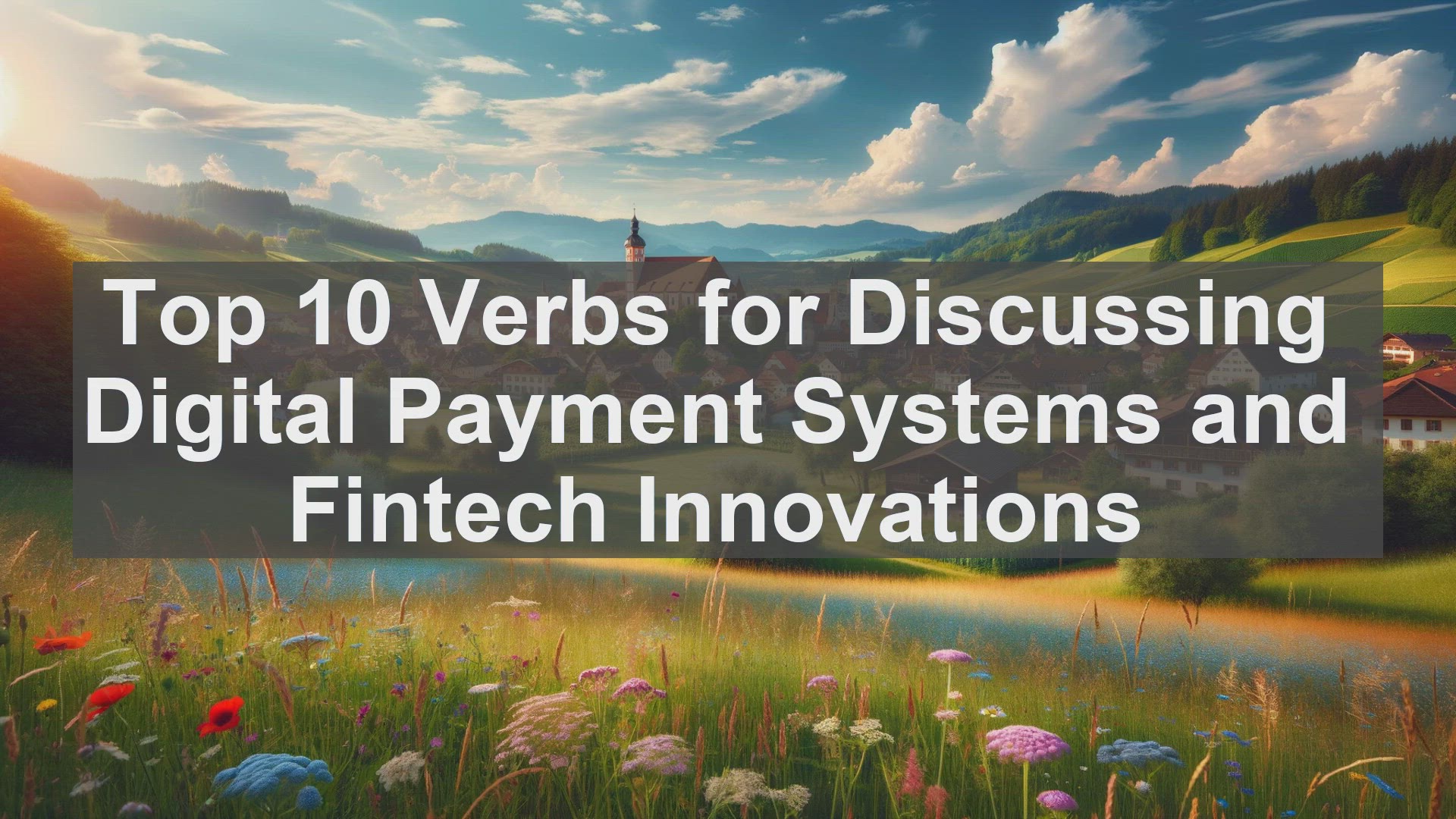
Top 10 Verbs for Discussing Digital Payment Systems and Fint...
40 views · Dec 7, 2023 englishteststore.net
Top 10 Verbs for Discussing Digital Payment Systems and Fintech Innovations 1. Facilitate The first verb on our list is 'facilitate.' In the context of digital payment systems, this verb refers to the act of making transactions or processes easier and more convenient. Fintech innovations often aim to facilitate various aspects of financial transactions, whether it's the speed, security, or accessibility. For example, mobile payment apps facilitate quick and contactless transactions, eliminating the need for physical cash or cards. 2. Streamline Next up, we have 'streamline.' This verb implies the process of making something more efficient and removing any unnecessary complexities. In the realm of digital payments, streamlining can involve integrating different payment methods into a single platform or simplifying the steps required to complete a transaction. By streamlining the payment process, businesses can enhance the overall customer experience and reduce the chances of errors or delays. 3. Enhance When we talk about 'enhancing' digital payment systems, we're referring to the act of improving or adding value to them. This can be through the introduction of new features, enhanced security measures, or even personalized experiences. Fintech companies are constantly striving to enhance their payment solutions, ensuring they meet the evolving needs and expectations of users in an ever-changing digital landscape. 4. Integrate In the world of digital payments, 'integration' is a crucial verb. It signifies the process of combining different systems or platforms to work seamlessly together. For instance, integrating a payment gateway with an e-commerce website allows customers to make secure online purchases without any disruptions. Integration not only simplifies the payment process but also ensures data accuracy and consistency. 5. Innovate No discussion on fintech and digital payments is complete without the mention of 'innovation.' This verb encapsulates the continuous drive to develop new ideas, technologies, and solutions that revolutionize the way we transact. From blockchain-based currencies to biometric authentication, the realm of digital payments is witnessing constant innovation, with the aim of making transactions more secure, efficient, and inclusive. 6. Enable To 'enable' in the context of digital payments means to provide the necessary tools, infrastructure, or capabilities for a transaction to occur. Fintech innovations often enable individuals or businesses to carry out transactions that were previously not possible or were more challenging. For example, peer-to-peer payment platforms enable individuals to transfer funds directly to each other, bypassing traditional intermediaries. 7. Safeguard When it comes to digital payments, 'safeguarding' is of utmost importance. This verb refers to the act of protecting sensitive information, such as financial data or personal details, from unauthorized access or potential threats. Fintech companies employ various measures, such as encryption and multi-factor authentication, to safeguard the integrity and confidentiality of transactions, instilling trust among users. 8. Adapt The world of digital payments is dynamic, with new technologies and trends emerging regularly. To stay relevant, it's crucial to 'adapt.' This verb implies the ability to adjust or modify one's strategies, processes, or systems in response to changing circumstances. Fintech companies that can adapt quickly to market shifts or user demands are more likely to thrive in the fast-paced digital landscape. 9. Collaborate Collaboration is key in the fintech and digital payment ecosystem. This verb signifies the act of working together, often across different sectors or industries, to achieve common goals. For instance, a collaboration between a fintech company and a traditional bank can result in the development of innovative payment solutions that combine the agility of fintech with the trust and stability of traditional banking. 10. Disrupt Our final verb, 'disrupt,' is often associated with transformative changes in the fintech space. To 'disrupt' means to fundamentally alter or challenge existing norms, practices, or systems. Fintech innovations, such as peer-to-peer lending or robo-advisors, have disrupted traditional financial models, offering alternative and often more accessible options. Disruption, though disruptive in the short term, can lead to long-term positive changes and advancements.

Top 10 Phrases for Discussing Sustainable Urban Food Trucks
85 views · Jan 12, 2024 englishteststore.net
Top 10 Phrases for Discussing Sustainable Urban Food Trucks Introduction: The Rise of Urban Food Trucks Hello, students! Today, we're going to dive into the world of sustainable urban food trucks. With the rise of these mobile culinary delights, it's crucial to understand the language and concepts surrounding them. 1. Eco-Friendly Food Trucks: A Necessity Sustainability is no longer a choice but a necessity. Eco-friendly food trucks, equipped with energy-efficient appliances and renewable power sources, reduce carbon emissions and contribute to cleaner air quality. 2. Farm-to-Truck: The Local Food Movement The farm-to-truck concept emphasizes sourcing ingredients from local farmers. By doing so, food trucks support the local economy, reduce transportation emissions, and ensure fresher, healthier meals for customers. 3. Composting: Closing the Loop Food waste is a significant concern. Food trucks that implement composting systems not only reduce landfill waste but also create nutrient-rich soil, completing the sustainability cycle. 4. Water Conservation: Every Drop Counts Water is a precious resource. Food trucks that employ water-saving techniques like low-flow faucets and water-efficient dishwashing methods contribute to water conservation efforts. 5. Solar Power: Harnessing the Sun's Energy With advancements in solar technology, food trucks can now rely on clean, renewable energy. Solar panels on the truck's roof can power appliances, reducing the need for traditional electricity sources. 6. Waste Reduction: Minimizing Packaging Excessive packaging leads to more waste. Food trucks that prioritize eco-friendly packaging options like biodegradable containers and utensils significantly reduce their environmental footprint. 7. Community Engagement: Beyond Food Food trucks are more than just a place to grab a quick bite. They often act as community hubs, hosting events, and supporting local initiatives, fostering a sense of togetherness and social responsibility. 8. Menu Innovation: Plant-Based Options The demand for plant-based meals is on the rise. Food trucks that offer creative, delicious plant-based options not only cater to a growing customer base but also contribute to reducing the environmental impact of animal agriculture. 9. Food Safety: Ensuring Health and Well-Being Food trucks adhere to strict safety regulations to ensure the meals they serve are safe and hygienic. Regular inspections and proper food handling practices are essential for customer well-being. 10. Collaboration: The Power of Partnerships By collaborating with local businesses, food trucks can create a network of support. This not only benefits the food truck itself but also strengthens the local economy as a whole. Conclusion: The Future of Sustainable Food Trucks As the food truck industry continues to grow, so does the importance of sustainability. By incorporating these phrases into your discussions, you'll be well-equipped to contribute to the ongoing dialogue on sustainable urban food trucks.